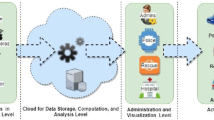Abstract
One of the most serious problems in modern society is that internet users are deceived by various fake information. In this paper, we analyse a scenario based on an actual incident of fraud called business email compromise (BEC). We suppose that each email, in the incident, step-wisely changes user’s thinking and makes him or her believe the emails. If fraud has such a step-by-step mechanism, it allows us to consider counter measures for dissuading a user from decision-making on the way. We discuss features and factors of the incident based on formulations of Channel theory. Our analysis revealed that each email message influenced user’s decision-making by what kind of logical trap. It can be fundamental knowledge that is capable of warning the user with predicting logical traps. This paper contributes to providing a novel viewpoint to develop systems for detecting deception of BEC.




Similar content being viewed by others
Notes
If emails resemble perfectly authentic ones, we suppose that M can have only one type, or all elements in M can be written as “1”. In that sense, Fig. 4 implies that Bob and Charlie can have some reactions when emails resemble imperfectly authentic ones.
References
Jones HS, Towse JN, Race N, Harrison T (2019) Email fraud: the search for psychological predictors of susceptibility. PLoS One 14(1):15
Webster J, Drew JM (2016) Policing advance fee fraud (AFF): experiences of fraud detectives using a victim-focused approach. Int J Police Sci Manag 19(1):39–53
Nizamani S, Memon N, Glasdam M, Nguyen DD (2014) Detection of fraudulent emails by employing advanced feature abundance. Egypt Inf J 15(3):169–174
Aggarwal S, Kumar V, Sudarsan SD (2014) Identification and detection of phishing emails using natural language processing techniques. In: Proceedings of the 7th International Conference on Security of Information and Networks (SIN), 6 pages
Ramachandran A, Dasgupta A, Feamster N, Weinberger K (2011) Spam or ham? characterizing and detecting fraudulent “not spam” reports in web mail systems. In: Proceedings of the 8th Annual Collaboration, Electronic messaging, Anti-Abuse and Spam Conference (CEAS), pp 210–219
Shafqat W, Lee S, Malik S, Kim H (2016) The language of deceivers: linguistic features of crowdfunding scams. In: Proceedings of the 25th International Conference Companion on World Wide Web (WWW), pp 99–100
Everett RM, Nurse JRC, Erola A (2016) The anatomy of online deception: what makes automated text convincing? In: Proceedings of the 31st Annual ACM Symposium on Applied Computing (SAC), pp 1115–1120
Toma CL, Hancock JT (2010) Reading between the lines: linguistic cues to deception in online dating profiles. In: Proceedings of the 2010 ACM conference on Computer supported cooperative work (CSCW), pp 5–8
Medvet E, Kirda E, Kruegel C (2008) Visual-similarity-based phishing detection. In: Proceedings of the 4th International Conference on Security and Privacy in Communication Networks (SecureComm), 6 pages
Dhamija R, Tyger JD, Hearst M (2006) Why phishing works. In: Proceedings of the SIGCHI Conference on Human Factors in Computing Systems (CHI), pp 581–590
Pattanaphanchai J, O’Hara K, Hall W (2013) Trustworthiness criteria for supporting users to assess the credibility of web information. In: Proceedings of the 22nd International Conference on World Wide Web Companion (WWW Companion), pp 1123–1130
Internet Crime Complaint Center (2018) Business E-mail compromise The 12 billion dollar scam. https://www.ic3.gov/media/2018/180712.aspx. Accessed 24 Mar 2020
Nishigaki T, Takenouchi T (2009) The informatic turn-who observes the “Infosphere”? J Socio-Inf 2(1):81–90
Nishigaki T (2008) Fundamental informatics II—for vital organization (in Japanese). NTT Publishing, Tokyo
Barwise J, Seligman J (1997) Information flow -the logic of distributed systems. Cambridge University Press, Cambridge
Internet Crime Complaint Center (IC3) (2016) Business e-mail compromise: the 3.1 billion dollar scam. https://www.ic3.gov/media/2016/160614.aspx. Accessed 24 Mar 2020
Chang EJ, Hussain FK, Dillon TS (2005) Fuzzy nature of trust and dynamic trust modeling in service oriented environments. In: Proceedings of The Workshop on Secure Web Services (SWS), pp 75–83
Ma J, Orgun MA (2006) Trust management and trust theory revision. IEEE Trans Syst Man Cybern Part A 36(3):451–460
Cho JH, Chan K, Adali S (2015) A survey on trust modeling. ACM Comput Surv (CSUR) 48(2):28:1–28:40
Guo J, Chen IR, Jeffrey JP Tsai (2017) A survey of trust computation models for service management in internet of things systems. Comput Commun 97:1–14
Zhong Y, Bhargava B, Lu Y, Angin P (2014) A computational dynamic trust model for user authorization. IEEE Trans Dependable Secure Comput 12(1):1–15
Chenon J, Edomonson W, Esterline A, Neogi N (2014) Formal framework for ensuring consistent system and constraint theories in the design of small satellite systems. In: Proceedings of the Poster Workshop at 5th International Conference on Complex Systems Design & Management (CSD&M), pp 263–281
Bildstein A, Feng J, Bauernhansl T (2018) Information flow-based capability matching service for smart manufacturing. Procedia CIRP 72:1015–1021
Allwein G (2004) A qualitative framework for Shannon information theories. In: Proceedings of Workshop on New Security Paradigms (NSPW), pp 23–31
Schorlemmer M, Kalfoglou Y (2005) Progressive ontology alignment for meaning coordination: an information-theoretic foundation. In: Proceedings of Autonomous Agents and Multiagent Systems (AAMAS), pp 737–744
Atencia M, Schorlemmer M (2007) A formal model for situated semantic alignment. In: Proceedings of Autonomous Agents and Multiagent Systems (AAMAS), pp 1278–1285
Koster A, Sabater-Mir J, Schorlemmer M (2010) Engineering trust alignment: a first approach. In: Proceedings of the 13th International Workshop on Trust in Agent Societies (TRUST), 12 pages
Kawakami H, Suto H, Handa H, Katai O, Shiose T (2008) Analyzing diverse interpretation as benefit of inconvenience. In: Proceedings of International Symposium on Symbiotic Nuclear Power Systems for 21st Century (ISSNP), vol. 2, pp 75–81
Myojin S, Babaguchi N (2019) A logical consideration on deceived person’s thinking. Artif Life Robot (AROB) 24(1):114–118
Shiose T, Motoyoshi T, Toda K, Kawakami H, Katai O (2006) Theoretical analysis of process showing effects for skill succession (in Japanese). Trans Hum Interface Soc 8(4):487–496
Motoyoshi T, Hattori T, Kawakami H, Shiose T, Katai O (2008) A mathematical framework for interpreting playing environments as media for information flow. Adv Hum-Comput Interact 2008:7
Kawakami H (2005) Channel theory and its potential to apply to systems science (in Japanese). Syst Control Inf 49(2):59–63
Suto H, Taniguchi T, Kawakami H (2011) A study of communication scheme for media biotope. In: Proceedings of SICE Annual Conference, pp 206–209
Patitad P, Suto H (2015) A modeling of collaboration mechanism of design process based on channel theory. J Robot Netw Artif Life 2(1):46–49
Gupta G (1994) Chu spaces: a model of concurrency, Ph. D Thesis, Computer Science Department. Stanford University
Mikami Y (2018) Yomiuri online (in Japanese). https://www.yomiuri.co.jp/science/goshinjyutsu/20180109-OYT8T50178.html. Accessed 24 Mar 2020
Yoshino J, Shiga Y, Nikkei staff writers (2017) Nikkei Asian Review. https://asia.nikkei.com/Business/JAL-falls-prey-to-biggest-email-swindle-against-Japan-Inc. Accessed 24 Mar 2020
Kitaoka H (2017) (6) From information to intelligence: the forefront of intelligence studies from the viewpoint of analysis (in Japanese). J Inf Process Manag 60(8):583–588
Otani T (2017) (3) How should we treat with false information on the internet? (in Japanese). J Inf Process Manag 60(5):335–338
Uchida K (2008) The trends of information security psychology and trust—the activities of the information security psychology and the trust (SPT) research group - (in Japanese). IPSJ SIG Tech Rep 2008–CSEC–41(1):1–6
Azaria A, Richardson A, Kraus S (2014) An agent deception detection in discussion based environments (extended abstract). In: Proceedings of the 18th ACM conference on computer supported cooperative work and social computing (AAMAS), pp 1387–1388
Elkins AC, Twyman N, Proudfoot JG, Burgoon JK, Nunamaker JF Jr (2016) Embodied conversational agent-based deception detection. In: Proceedings of SAI intelligent conference, pp 797–803
Author information
Authors and Affiliations
Corresponding author
Additional information
Publisher's Note
Springer Nature remains neutral with regard to jurisdictional claims in published maps and institutional affiliations.
This work was supported by JSPS KAKENHI Grant Number JP16H06302.
This work was presented in part at the 24th International Symposium on Artificial Life and Robotics (Beppu, Oita, January 23–25, 2019).
About this article
Cite this article
Myojin, S., Babaguchi, N. A logical consideration on fraudulent email communication. Artif Life Robotics 25, 475–481 (2020). https://doi.org/10.1007/s10015-020-00597-4
Received:
Accepted:
Published:
Issue Date:
DOI: https://doi.org/10.1007/s10015-020-00597-4




